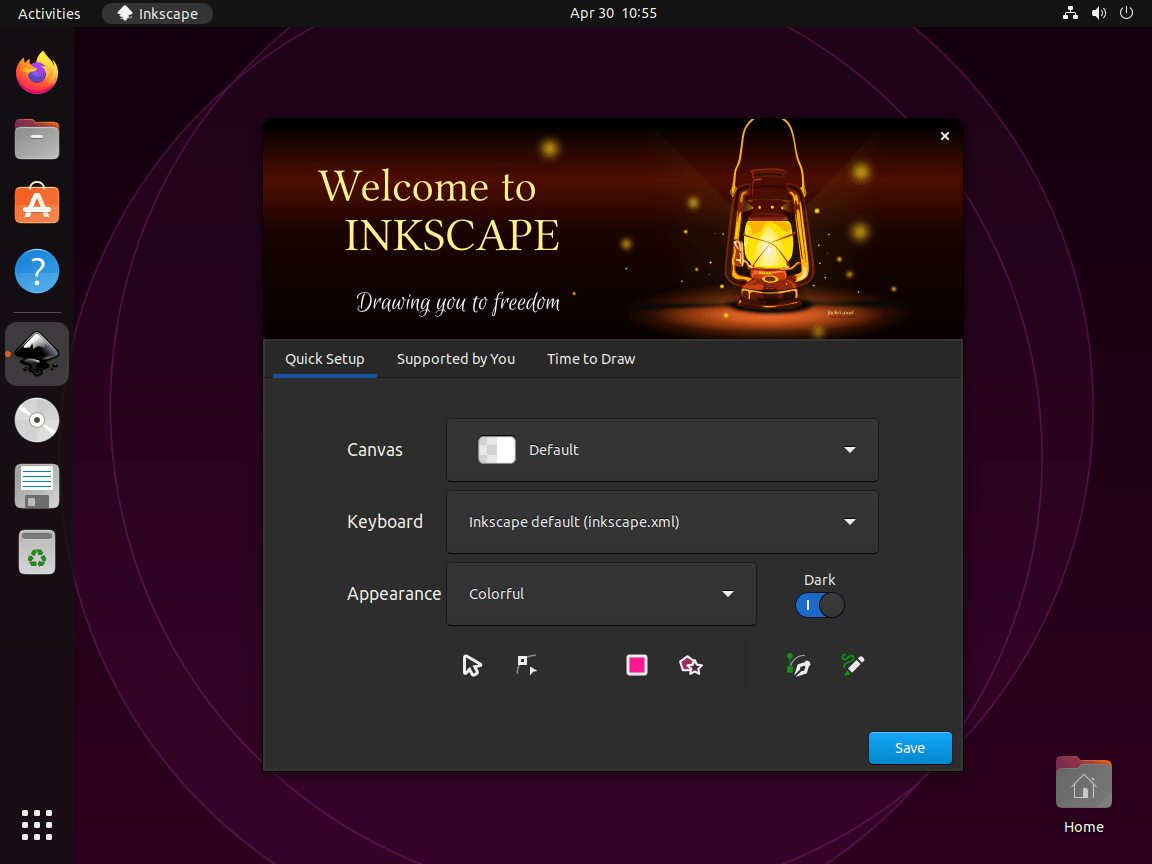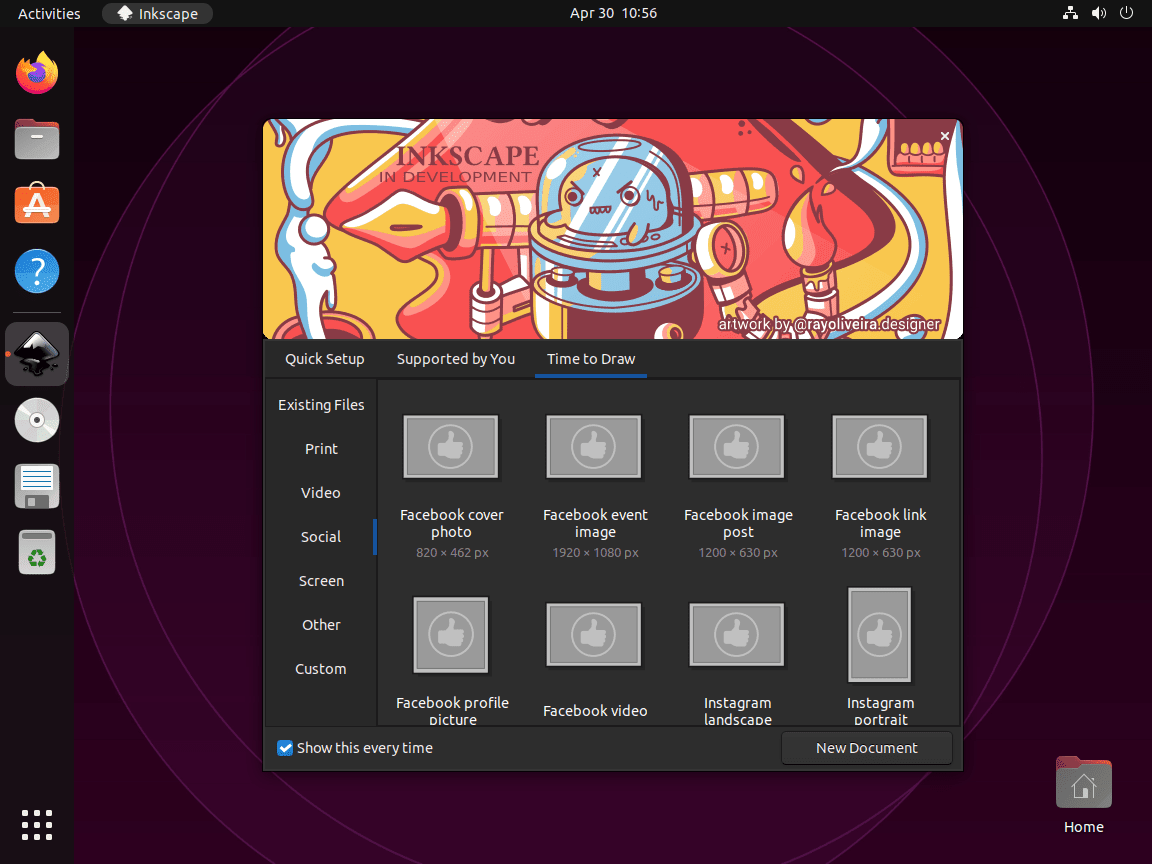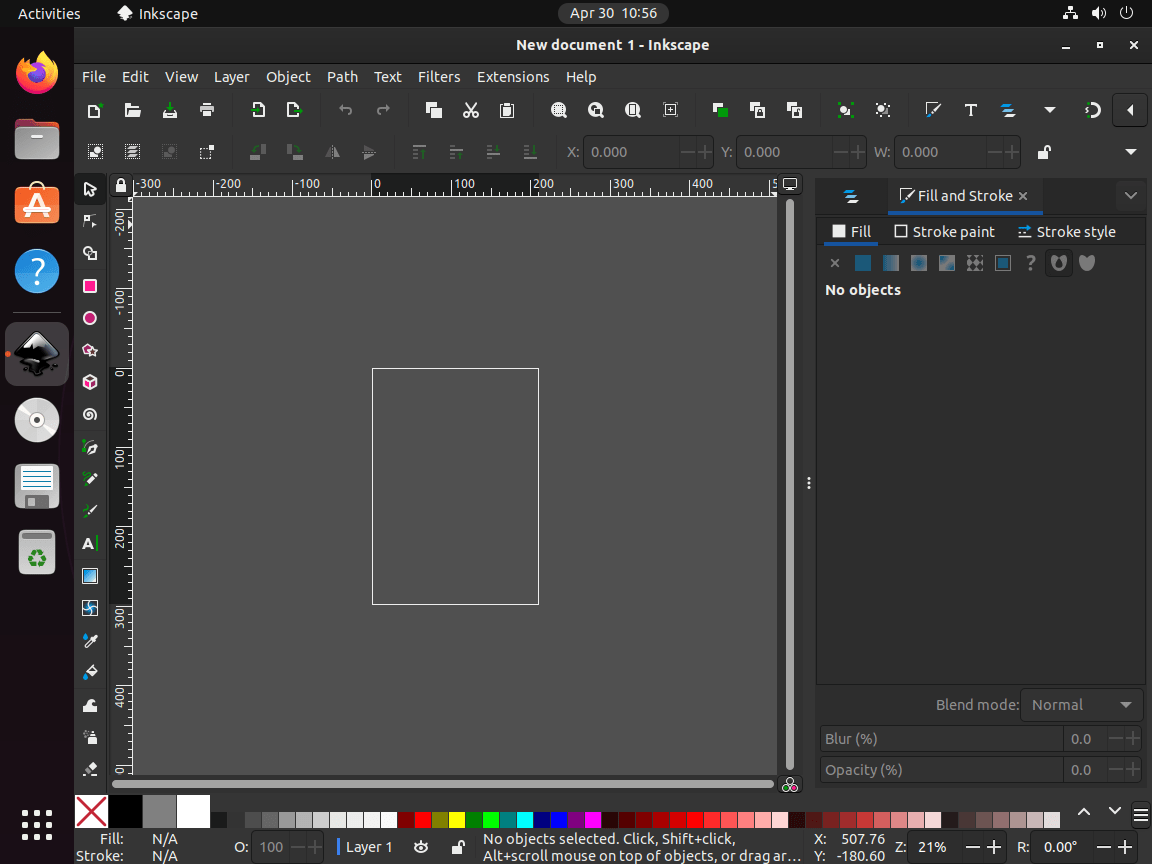Inkscape is an open-source vector graphics editor for creating and editing SVG files, designing scalable logos, and exporting artwork to PDF or PNG formats. You will install Inkscape on Ubuntu through APT repositories, the official PPA for newer releases, Flatpak for sandboxed deployment, or Snap for automatic updates. After installation, you will verify the version, launch the application, and have immediate access to drawing tools, path operations, and template libraries for your first design project.
Choose Your Inkscape Installation Method
There are three primary ways to install Inkscape on Ubuntu, each with its own advantages depending on your needs for stability versus the latest features.
| Method | Channel | Version | Updates | Best For |
|---|---|---|---|---|
| APT (Default) | Ubuntu Repository | Stable (Older) | Automatic | Users prioritizing system stability |
| PPA | Inkscape PPA | Latest Stable | Automatic | Users wanting new features via APT |
| Snap (Ubuntu Default) | Snapcraft | Latest Stable/Edge | Automatic | Native Ubuntu package manager |
| Flatpak | Flathub | Latest Stable | Automatic | Desktop users needing sandboxing |
For most Ubuntu users, Snap is the recommended method as it comes pre-installed and provides automatic updates with the latest stable release. The PPA offers newer versions through APT, while Flatpak provides sandboxing. The default Ubuntu repository version lags behind upstream releases but offers maximum stability.
This guide supports Ubuntu 22.04 LTS and 24.04 LTS installations. The Inkscape PPA typically supports the two most recent LTS releases, while Snap (pre-installed on Ubuntu) and Flatpak remain compatible across all versions. Commands shown work identically on both supported LTS releases.
Method 1: Install Inkscape via APT
Update Ubuntu System Packages Before Inkscape Installation
Before installing Inkscape, you must update your Ubuntu system to ensure you have the latest packages and security updates. To do this, execute the following command in your terminal:
sudo apt update && sudo apt upgradeSelect Inkscape Installation Option
There are two methods for installing Inkscape using APT. You can install the version available in the Ubuntu repository or add the Inkscape PPA for the latest stable or nightly version.
Option 1: Install Inkscape from Ubuntu Repository
Inkscape is available in the default Ubuntu repository. This version is recommended for users who need a stable version for basic usage and do not require the latest features. Note that Ubuntu LTS releases may not have the most recent updates for Inkscape.
To install Inkscape from the Ubuntu repository, enter the following command in your terminal:
sudo apt install inkscapeVerify the installation by checking the installed version:
inkscape --versionInkscape 1.2.2 (b0a8486541, 2022-12-01)
Option 2: Install Inkscape via Inkscape PPA
For users who want the latest stable version of Inkscape without using Flatpak or Snap, you can import the Inkscape PPA. You can choose between the stable PPA or the nightly PPA.
First, ensure that the required dependencies are installed by executing the following command:
sudo apt install software-properties-common -yTo import the stable Inkscape PPA, run the following command:
sudo add-apt-repository ppa:inkscape.dev/stable -yFor those who prefer the nightly version, use this command instead:
sudo add-apt-repository ppa:inkscape.dev/trunk -yImport only one PPA. If you want to switch from stable to nightly (or vice versa), remove the existing PPA first to avoid dependency conflicts. The stable PPA installs as
inkscape, while the trunk PPA uses theinkscape-trunkpackage name.
After adding the desired PPA, update your package list to reflect the new changes:
sudo apt updateFinally, install Inkscape using the following command:
sudo apt install inkscape -yAlternatively, to install the Inkscape Development version on Ubuntu, run the following command:
sudo apt install inkscape-trunk -yWhen installing the development version, it’s critical to use the inkscape-trunk install command.
Verify the PPA installation using the version command:
inkscape --versionInkscape 1.4.2 (ebf0e940d0, 2024-12-05)
Method 2: Install Inkscape via Snap
Snap is Ubuntu’s default universal package manager and comes pre-installed on Ubuntu 16.04 and later. This method provides automatic updates and supports both stable and development channels.
Verify Snap Installation
Ubuntu includes Snap by default, but you can verify it is installed and install it if needed:
snap versionIf Snap is not installed, add it with the following command:
sudo apt update && sudo apt install snapd -yInstall Inkscape via Snap Command
Install Inkscape from the Snapcraft store using the following command:
sudo snap install inkscapeFor the development version with bleeding-edge features, use the edge channel:
sudo snap install inkscape --edgeThe edge channel provides development builds with the latest features but may contain bugs. The stable channel (default) is recommended for production work. You can switch channels later using
sudo snap refresh inkscape --channel=stableor--channel=edge.
Verify the Snap installation:
snap list inkscapeName Version Rev Tracking Publisher Notes inkscape 1.4 9876 latest/stable inkscape✓ -
Method 3: Install Inkscape via Flatpak and Flathub
The Flatpak method provides automatic sandboxing and the latest stable release from Flathub. Flatpak requires initial setup on Ubuntu systems.
If Flatpak is not installed on your system, follow our Flatpak installation guide to set up the Flatpak framework and add the Flathub repository—this typically takes under five minutes.
Install Inkscape via Flatpak Command
With Flatpak and Flathub configured, install Inkscape using the following command:
flatpak install flathub org.inkscape.Inkscape -yVerify the Flatpak installation:
flatpak list --app | grep inkscapeInkscape org.inkscape.Inkscape 1.4.2 stable system
Launch Inkscape on Ubuntu via CLI or GUI
Congratulations! Now that you have successfully installed Inkscape on your system, it’s time to learn how to launch the application using various methods, depending on your installation type.
CLI Method to Launch Inkscape
For users who have installed Inkscape using the APT or PPA methods, you can launch the application by typing the following command in your terminal:
inkscapeIf you have installed Inkscape using the Flatpak method, you must use a different command to launch the application. Enter the following command in your terminal:
flatpak run org.inkscape.InkscapeFor users who have installed Inkscape as a Snap package, you can launch the application using the command below:
snap run inkscapeGUI Method to Launch Inkscape
While launching Inkscape from the terminal is helpful in some cases, most desktop users will prefer to launch the application using their desktop environment. To do this, follow the path below:
Activities > Show Applications > Inkscape


Manage Inkscape Updates and Removal
Update Inkscape
Inkscape updates automatically through your chosen package manager. APT and PPA installations update during system-wide upgrades, while Snap and Flatpak check for updates daily. You can manually trigger updates using the commands below based on your installation method.
APT or PPA Update Method
If you installed Inkscape using APT or the Inkscape PPA, run the following command to update:
sudo apt update && sudo apt upgradeSnap Update Method
Snap packages update automatically, but you can manually refresh using this command:
sudo snap refresh inkscapeFlatpak Update Method
For Flatpak installations, use the following command to update:
flatpak update org.inkscape.Inkscape -yRemove Inkscape
If you no longer need Inkscape on your system, follow the instructions below to uninstall it based on your initial installation method.
APT or PPA Remove Method
To remove Inkscape installed via APT or PPA, run the following commands:
sudo apt remove inkscape -y
sudo apt autoremove -yIf you installed Inkscape using one of the PPAs, you should also remove the associated repository. For the stable PPA, use this command:
sudo add-apt-repository --remove ppa:inkscape.dev/stable -yFor the trunk (nightly) PPA, execute this command:
sudo add-apt-repository --remove ppa:inkscape.dev/trunk -yVerify removal by checking that Inkscape is no longer installed:
which inkscapeThis command should return no output if Inkscape was successfully removed.
Snap Remove Method
If you installed Inkscape with Snap, use the following command to remove it:
sudo snap remove inkscapeVerify removal:
snap list inkscapeerror: no matching snaps installed
Flatpak Remove Method
To uninstall Inkscape installed through Flatpak, run the following command:
flatpak uninstall org.inkscape.Inkscape -yVerify removal:
flatpak list --app | grep inkscapeThis command should return no output if Inkscape was successfully removed.
Troubleshooting Common Inkscape Installation Issues
This section addresses common issues you may encounter when installing or running Inkscape on Ubuntu, along with diagnostic steps and solutions.
PPA Dependency Conflicts
If you encounter dependency conflicts when adding both stable and trunk PPAs simultaneously, you will see errors similar to:
The following packages have unmet dependencies: inkscape : Depends: libpoppler-glib8 but it is not installable
Check which PPAs are currently active:
grep -r "inkscape" /etc/apt/sources.list.d/Remove any conflicting PPA before adding a new one:
sudo add-apt-repository --remove ppa:inkscape.dev/stable -y
sudo add-apt-repository --remove ppa:inkscape.dev/trunk -y
sudo apt updateThen add only the PPA you need and install Inkscape.
Flatpak Remote Already Exists Error
When adding Flathub, you may see this error if the remote was previously configured:
error: Remote "flathub" already exists
Verify the Flathub remote is properly configured:
flatpak remotesIf Flathub appears in the list, proceed directly to installing Inkscape. If the remote is misconfigured, remove and re-add it:
flatpak remote-delete flathub
flatpak remote-add --if-not-exists flathub https://flathub.org/repo/flathub.flatpakrepoSnap Refresh Fails or Shows Revision Errors
If Snap updates fail with revision errors, you may see messages like:
error: cannot refresh "inkscape": snap has no updates available
Check the current channel and available channels:
snap info inkscapeIf you are on the edge channel and want to switch back to stable:
sudo snap refresh inkscape --channel=stableVerify the channel switch was successful:
snap list inkscapeConclusion
You have installed Inkscape on Ubuntu through APT repositories, the official PPA for the latest stable release, Snap for native Ubuntu package management, or Flatpak for sandboxed deployment. You verified the installation with version checks, learned how to launch the application from the terminal or desktop menu, and now have access to drawing tools, path operations, and template libraries. Keep Inkscape updated through your chosen package manager and reference the troubleshooting section if you encounter dependency conflicts or channel switching issues. For complementary creative workflows, explore how to install GIMP on Ubuntu for raster image editing, install Blender on Ubuntu for 3D modeling and animation, or install Krita on Ubuntu for digital painting and illustration work.


Inkscape PPA stable. Installation ok. Thank you.